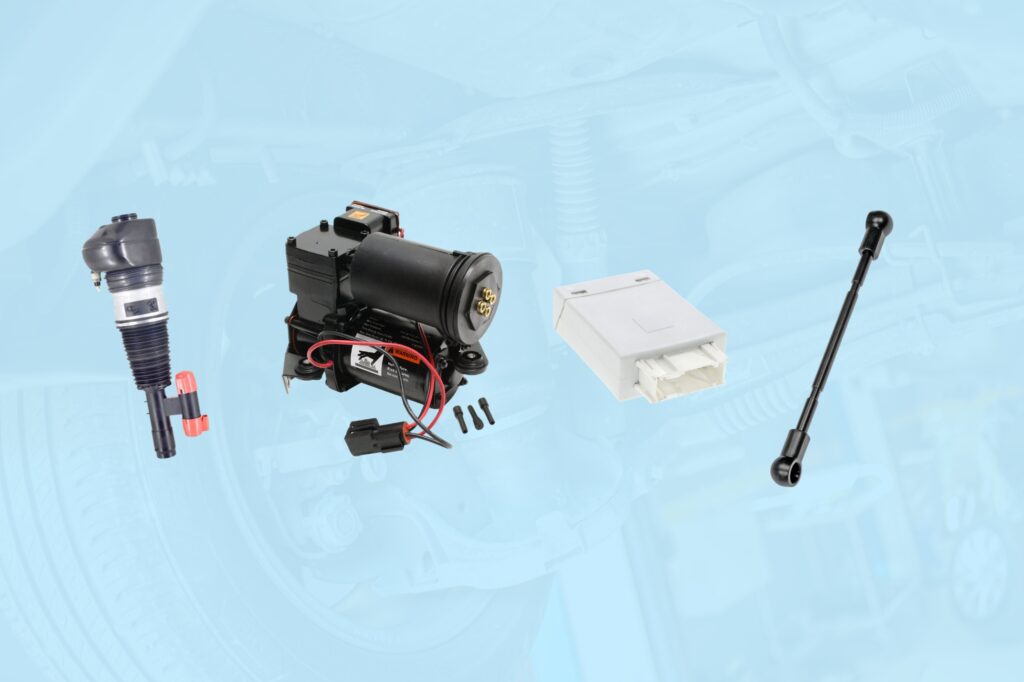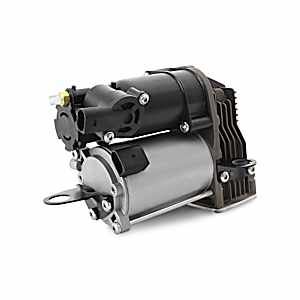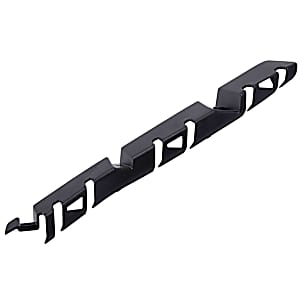Your air suspension system does a lot of things for you一it enhances your ride comfort, improves ride height, and produces higher corner speeds compared to conventional suspension systems. Heavy-duty driving is also more comfortable with this setup since vibration is significantly reduced.
However, you won’t be able to enjoy all of these perks when one part of the system is unable to do its job.
Check out this list to find out which parts might need to be repaired or replaced to restore your air suspension system’s performance.

Air Spring
The air spring is an inflatable rubber bellow that can raise or lower a vehicle’s ride height. In most cases, you’ll find the air spring on top of the strut, functioning the same way as its counterpart in a conventional suspension.
Air springs tend to provide more comfort and shock absorption when driving compared to coilovers, but they’re not suitable for hardcore racing applications.
If you plan to get your vehicle performance-ready, you might want to switch to a traditional coilover setup.
Average Price Range: $100-$250
Recommended Brands:
Air Suspension Strut
An air suspension strut replaces a conventional hydraulic strut. Easy ride height adjustment is only one of the many benefits of using an air suspension strut, adding to the overall convenience of an air suspension setup.
Instead of a hydraulic casing, air suspension struts come with an airbag. Using the compressor and air lines, the air struts inflate or deflate the airbag as needed.
Fully bagged vehicles will usually have air struts on each corner. These air struts generally come with built-in caster or camber adjustments.
With proper maintenance, air suspension struts can last up to 80,000 miles with little to no issues. However, harsh driving conditions and poor driving habits may cause them to wear down earlier than designed.
Average Price Range: $500-$1,000
Recommended Brands:
Air Suspension Compressor
The air suspension compressor is the heart of any air suspension setup.
The compressor produces air that inflates the bellows to raise your vehicle’s ride height.
The compressor needs to be hooked up to a power source and usually works as soon as your vehicle starts and related components detect low air pressure in the system.
Because the air compressor is integral to the quality of your vehicle’s suspension, it’s important to keep an eye out for signs that point to immediate compressor replacement.
If you know your vehicle well enough, you should be able to notice a decrease in ride height if the compressor is faulty. This is because the airbags can’t be inflated anymore. Grinding, whining, or clicking noises may also point to issues related to the compressor.
Lastly, if you notice that your rides are bumpier than usual, you might need to take a look at your air suspension’s parts for any sign of trouble.
Average Price Range: $250-$500
Recommended Brands:
Automatic Ride Height Sensor Link
The ride height sensor and its related components like the ride height sensor link monitor the height position of your vehicle’s body.
For vehicles with an automatic level control feature, the sensor is also used for automatic leveling.
The ride height sensor is typically attached to the chassis. It monitors the movement of the sensor rod every time weight is added or subtracted from the vehicle.
Sensor inputs are sent to the electronic control unit (ECU). Depending on the input received, the ECU can activate the air compressor, inflating the air springs in the process.
Over time, moisture and debris can affect the sensor’s operation, causing the system to malfunction.
Average Price Range: $30-$50
Recommended Brands:
Air Suspension Compressor Filter
The air suspension compressor filter prevents contaminants from infiltrating critical compression assemblies, trapping oil, water, dirt, and other particulates.
By filtering the air, cylinders and valves can work smoothly. The compressor filter also prevents the seals from swelling and wearing prematurely.
In most cases, a typical air suspension compressor filter will have the following parts:
- Inlet
- Filter cap
- Air path
- Filter discharge
- Filter element
- Filter bowl
- Filter quiet zone
- Drain
Average Price Range: Less than $50
Recommended Brands:
 AC Delco Air Suspension Compressor Filters
AC Delco Air Suspension Compressor Filters
 GenuineXL Air Suspension Compressor Filters
GenuineXL Air Suspension Compressor Filters
 Mann-Filter Air Suspension Compressor Filters
Mann-Filter Air Suspension Compressor Filters
Air Suspension Control Module
The air suspension control module is the brain of the entire system. With a push of a button, the control module electronically opens or closes the valves that let air pass through the air springs to raise or lower the vehicle’s ride height.
Conventional air suspension operation involves pulsing some switches to adjust ride height. Today, Bluetooth-operated controls are widely available as well, allowing drivers to adjust their vehicle’s ride height using their smartphones.
Average Price Range: $250-$1,000
Recommended Brands:
Air Suspension Controller
You’ll come across various types of air suspension control module controllers in the market, including digital controllers, switch boxes, and wireless controllers.
Digital Controller
Digital air suspension controllers come with pressure and height-based leveling systems. They’re the most common type of controller in the market.
Height-based leveling will require you to install leveling arms on each corner of the vehicle. Meanwhile, pressure-based systems won’t require sensors, but you’ll need to monitor them more often than height-based ones.
Some digital controllers come with features like bluetooth connectivity, programmable pressure presets, and automatic calibration, among others.
Switch Box
The switch box is arguably the easiest type of controller to operate among the three. While this might be the case, this type lacks preset features you’ll find in a digital controller.
Most switch boxes are analog, so you’ll need to install gauges to monitor air pressure.
Wireless Controller
A wireless controller lets you adjust your air suspension system from outside of your vehicle. Similar to a digital controller, a wireless one lets you use your phone with the corresponding app to adjust ride height.
Average Price Range: $250-$500
Recommended Brands:
Any information provided on this Website is for informational purposes only and is not intended to replace consultation with a professional mechanic. The accuracy and timeliness of the information may change from the time of publication.



 Air Lift Air Springs
Air Lift Air Springs Unity Air Springs
Unity Air Springs Arnott Air Springs
Arnott Air Springs Vemo Air Suspension Struts
Vemo Air Suspension Struts Arnott Air Suspension Struts
Arnott Air Suspension Struts FCS Air Suspension Struts
FCS Air Suspension Struts Arnott Air Suspension Compressor
Arnott Air Suspension Compressor Unity Air Suspension Compressor
Unity Air Suspension Compressor Dorman Air Suspension Compressor
Dorman Air Suspension Compressor AC Delco Automatic Ride Height Sensor Links
AC Delco Automatic Ride Height Sensor Links Dorman Automatic Ride Height Sensor Links
Dorman Automatic Ride Height Sensor Links Air Lift Air Suspension Control Modules
Air Lift Air Suspension Control Modules GenuineXL Air Suspension Control Modules
GenuineXL Air Suspension Control Modules







 AC Delco Air Suspension Controllers
AC Delco Air Suspension Controllers Vemo Air Suspension Controllers
Vemo Air Suspension Controllers















